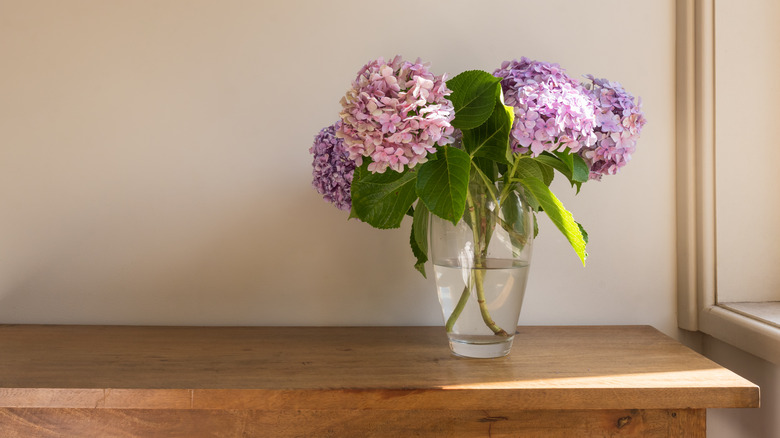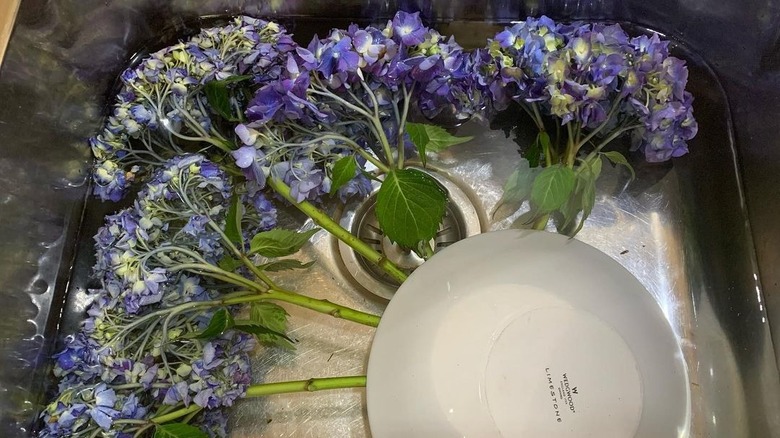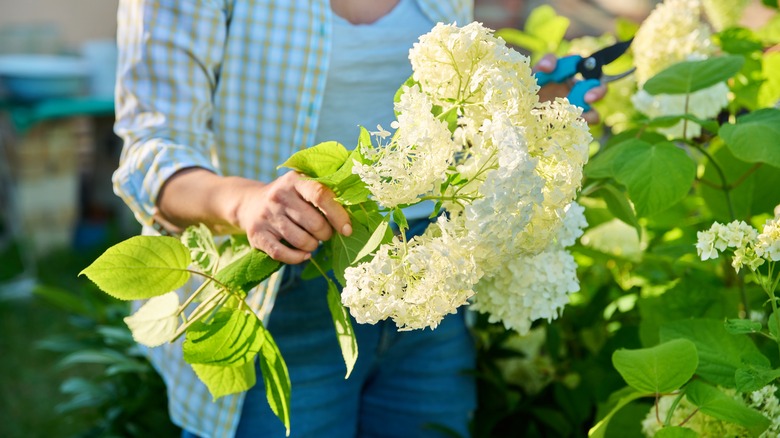How To Revive Your Wilted Hydrangeas
Hydrangeas are one of the most beautiful flowers to keep in a bouquet, but they often start wilting almost as soon as they are cut from the bush. When hydrangea stems are cut, the sap begins to form a seal around the wound, much like when you get a cut on your finger. This healing mechanism is great to help hydrangea plants survive, but when sap seals over the stem on your flowers, water isn't able to reach the blooms, and the flower wilts.
Once the seal forms around the hydrangea stem, it can be hard to revive droopy blooms, no matter how often you add flower food or trim the stems. It might sound odd, but to revive your wilted hydrangea blooms, all you have to do is give them a good soak directly through their petals! After all, who doesn't feel a little better after a bath?
Whether you harvest hydrangeas in your garden or you've just been gifted a beautiful bouquet, a vase full of droopy flowers is a sorry sight. Here's the step-by-step for bringing hydrangeas back to life, how to prevent them from drooping in the first place, and tips you can use to help them last as long as possible.
Soak to reset and refresh
Hydrangeas are known for being water-loving plants; their name actually comes from the Greek words "hydros" and "angos," which mean "water" and "jar," respectively. Because they require so much hydration, hydrangeas developed the special ability to absorb water directly through their flowers, stems, and leaves, rather than just the roots. Knowing this, you can effectively rehydrate your cut hydrangea blooms by soaking them in a bath of fresh water!
Start by filling the kitchen sink or a large bowl with warm water. Next, remove your blooms one by one from their container, trim about an inch off the stems, and immediately plunge the flowers into the water. Make sure the flowers are as submerged as possible, weigh them down with a plate if needed, then leave them to soak for at least an hour.
When the time is up, pull out a flower and gently shake the water off to see if the blooms are perkier. If they still seem droopy, your flowers may need to soak overnight. When you're done soaking the hydrangeas, pat them dry with a towel, pop them back into a vase of fresh water, and place them away from direct heat or sunlight. Of course, this method won't keep hydrangeas alive indefinitely, but it should perk them up and help them last a bit longer.
Prolonging the life of hydrangea blooms
If possible, water the hydrangea plant the night before you plan on cutting. The best time to cut hydrangea blooms is early in the morning, when the flowers are plump and hydrated, and the hot sun hasn't had a chance to cook them yet. When you head out to the garden to harvest some hydrangea blooms, be sure to bring a vase or bucket of water with you. Cut hydrangeas at an angle, then immediately plop them into the bucket so the sap won't have a chance to harden. If you're purchasing hydrangeas from a florist or grocery store, of course, you won't have control over when they're harvested, but you can still follow some tips to help them last longer in your arrangement.
Three of the most popular tricks to improve hydrangea lifespan are the boiling water method, smash method, and alum powder method. As soon as you bring your hydrangeas inside, put on a pot of boiling water. Turn off the stove, trim the stems, and hold the tip of each stem in the hot water for about 30 seconds before dropping it into the vase with room-temperature water. Alternatively, you can smash the end of the stems with a hammer or another blunt tool. Finally, consider dipping the tips of your stems in alum powder before arranging them in a vase.
All of these techniques keep sap from sealing off water flow, which can keep cut hydrangeas fresh for weeks.


